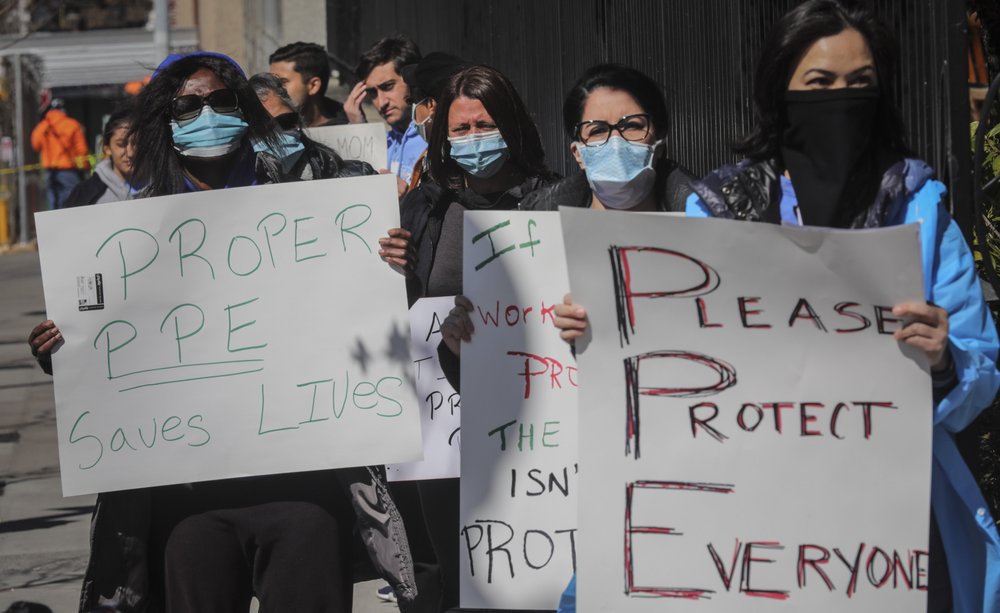
Nurses at Montefiore Medical Center Moses Division hold an "urgent community speak out" and press conference in front of the hospital, demanding N95s and other critical personal protective equipment to handle the COVID-19 outbreak, Thursday April 2, 2020, in New York. (Photo: AP)
Washington (People’s Daily) - A nurse at the Montefiore Medical Center in New York City told the Wall Street Journal, a doctor instructed nurses on March 19 to not use N95 masks to check on patients due to limited supplies.
According to the nurse, Jungoui Hwang, the doctor said, “If you cannot follow the new policy, you gotta leavel.”
Hwang said she raised exposure concerns but was told to “just be careful.” The hospital later said in an email that a notice of “significant punitive actions” for using an N95 mask was “sent in error.”
Last week, Montefiore directors sent an email to employees that said they would receive a fresh N95 mask twice a week regardless of the number of patients they saw. On Monday, the hospital told the nurse’s union it would distribute N95 masks daily.
As infection from the coronavirus (COVID-19) spreads, hospitals are facing extraordinary tension among health care providers and administrators. Now, over 200 healthcare workers are sick in New York. Mostly, staff and administrators are fighting over face masks and whether they should be worn outside of treatment rooms, and which kind of masks — thinner surgical ones, or heavier respiratory masks. Should they be worn at all times, only during procedures, or while visiting patients?
Some hospitals allow masks outside of treatment rooms and some even make them mandatory. But a others say they aren’t necessary at all times and don’t allow them.
The Centers for Disease Control and Prevention’s (CDC) guidance has changed several times. Currently, it said medical professionals don’t need to wear masks all of the time. It also said that if there’s not enough protective equipment available, homemade solutions like bandannas or scarfs are acceptable for health care workers.
Dr. Ming Lin, an emergency room doctor, wrote on Facebook that he was fired on Friday from his job at PeaceHealth St. Joseph Medical Center in Bellingham, Washington after making public his concerns about insufficient protection and testing at the hospital.
Administrators at a different hospital in Seattle, the Cherry Hill campus of Swedish Medical Center, threatened to indefinitely suspend an anesthesiologist, Dr. Oliver Small, for wearing a surgical mask when not directly involved in patient care, such as walking through a hallway.
Dr. Oliver Small‘s wife, Ms. Green wrote on Facebook that ’the hospital asked him to attend a meeting in which administrators told Small he could take off the mask or stop coming to work. “What is wrong with our health care system????!!!” Small confirmed the story but said the hospital had since changed its position on masks and that he was “very pleased” by the outcome. Since the incident, the hospital now allows “universal masking” — the ability to wear masks in any patient area.
A New York Times analyst said the tension falls into a larger context: In recent years, doctors have felt increasingly like employees working for cost-cutting companies putting profit ahead of medicine. That tension appears to have found an almost volcanic moment with the coronavirus pandemic.
The World Health Organization (WHO) and the CDC have said that doctors and nurses can use basic surgical masks when treating COVID-19 patients, switching to the more advanced N95 respirators if they’re carrying out procedures that might create aerosols.
But such recommendations assume that the virus isn’t generally airborne. Because it might be, health-care workers should err on the side of precaution by wearing N95s and using even better respirators for more dangerous procedures, argues Lisa Brousseau of the University of Illinois at Chicago.
The equipment is in short supply, but health-care workers at least deserve to know what the ideal measures are.
The Atlantic magazine commented that the mask debate is so intense because both the stakes and the uncertainty levels are so high. COVID-19 has moved so quickly that years of social change and academic debate have been compressed into a matter of months.
Academic squabbles are informing national policy. Masks are a symbol, yes, but not just of conscientiousness. They’re also emblematic of a world that is changing so quickly, no one has time to take a breath.
The Trump administration is expected to announce as soon as Thursday that all Americans should wear cloth masks or other face coverings if they go out in public, based on a forthcoming recommendation from the CDC that would mark a shift in federal guidance amid new concerns that COVID-19 is being spread by infected people who have no symptoms.


